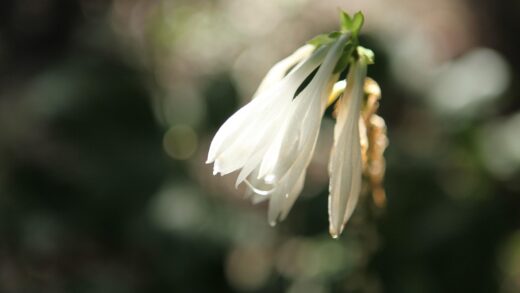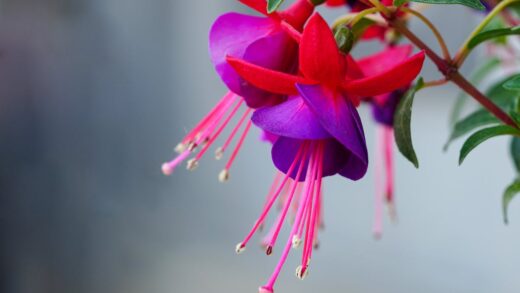Successfully guiding Geum coccineum through the winter months is a critical aspect of its care, ensuring its robust return and spectacular floral display the following spring. As a hardy perennial, it is well-equipped to handle cold temperatures, but a few preparatory steps in the autumn can significantly improve its chances of not just surviving, but thriving. The primary goals of winter care are to protect the plant’s crown—the vital point from which new growth emerges—from extreme cold, damaging freeze-thaw cycles, and excessive moisture. Proper winterization is a simple yet vital investment in the long-term health and performance of this beautiful garden plant.
The process of preparing scarlet avens for winter begins in the late autumn, as the growing season comes to a close. One of the most important steps is to cease all fertilization by the end of summer. Late-season feeding can stimulate a flush of new, tender growth that will not have time to harden off before the first frosts and will be easily damaged by the cold. It is essential to allow the plant to naturally slow down its growth and enter a state of dormancy. This gradual transition is a crucial part of its preparation for surviving the winter.
After the first few hard frosts have caused the foliage to yellow and die back, it is time for the autumn cleanup. Using a clean, sharp pair of secateurs or shears, cut the old foliage and flower stems back to just a few centimeters above the ground. This practice is important for several reasons. It removes dead plant material that could otherwise harbour pests or fungal diseases over the winter. It also tidies the garden bed, and most importantly, it exposes the crown of the plant, making it easier to apply a protective layer of winter mulch.
Good drainage becomes even more critical during the winter than at any other time of the year. Scarlet avens is particularly intolerant of “wet feet,” and sitting in cold, waterlogged soil is one of the most common reasons for the plant failing to reappear in the spring. Before winter sets in, ensure that the area around the plant is not in a low spot where water is likely to collect and that the soil is not overly compacted. The combination of freezing temperatures and saturated soil can lead to crown rot, which is almost always fatal.
The role of winter mulch
Applying a layer of winter mulch is perhaps the single most important action you can take to protect your scarlet avens over the cold months. The primary purpose of winter mulch is not to keep the plant warm, but rather to insulate the soil and keep it at a more constant temperature. This helps to prevent the damaging effects of repeated freezing and thawing cycles. These cycles can cause the ground to heave, which can lift the plant’s roots out of the soil, exposing them to desiccating winds and cold temperatures.
The best time to apply winter mulch is in late autumn or early winter, after the ground has frozen for the first time but before the coldest temperatures of the season arrive. Applying the mulch too early, while the ground is still warm, can trap heat and moisture, potentially encouraging rot and providing a cozy home for rodents that might chew on the plant’s crown. The goal is to wait until the plant is fully dormant and the ground is cold, and then lock in that cold, stable temperature.
Choose a loose, airy material for your winter mulch that will not become compacted and waterlogged over the winter. Excellent choices include shredded leaves, pine needles (pine straw), or marsh hay. These materials trap air, which is an excellent insulator, but they also allow for some moisture and air to penetrate the soil, preventing anaerobic conditions from developing. Avoid using heavy, dense materials like whole leaves that can mat down into a suffocating layer. Apply a generous layer, about 10-15 centimeters deep, over the crown of the plant.
In the early spring, as the threat of hard frosts begins to recede and you see the first signs of new growth emerging from the plant’s crown, it is time to remove the winter mulch. This should be done gradually over a week or two to allow the plant to acclimate to the changing temperatures and increasing light levels. Rake the mulch away from the crown gently to allow the new shoots to emerge unimpeded. This spring unveiling is a rewarding moment, revealing the healthy, dormant plant ready to burst into growth.
Care for container-grown plants
Wintering scarlet avens that are grown in containers requires a different approach, as their root systems are much more exposed to the cold than those of plants in the ground. In a pot, the roots are only insulated by a thin layer of plastic or ceramic and a small volume of soil, making them vulnerable to freezing solid, which can kill the plant. Therefore, container-grown Geum coccineum will need additional protection in all but the mildest of climates.
One of the simplest methods for protecting potted plants is to move the container to a more sheltered location. Placing the pot against a protected wall of the house, especially one with a southern exposure, can shield it from the worst of the winter winds and provide some radiant heat. Grouping several containers together can also help to create a microclimate where the pots insulate one another, reducing the temperature fluctuations experienced by each individual root ball.
For those living in colder climates where temperatures regularly drop well below freezing, more substantial protection is necessary. You can wrap the entire pot in several layers of bubble wrap or burlap to provide an extra layer of insulation for the roots. Another effective technique is to “heel in” the pot, which involves digging a hole in an empty garden bed and sinking the entire container into the ground up to its rim. The surrounding soil will then provide excellent insulation for the roots throughout the winter.
Alternatively, if you have a suitable space, you can move the container into an unheated but protected structure like a cold frame, a shed, or an attached garage. The goal is to keep the plant dormant but to protect its roots from the extreme cold. It is important that the location remains cold, as a warm environment could cause the plant to break dormancy too early. Container-grown plants will still need occasional, light watering throughout the winter, just enough to prevent the soil from drying out completely, perhaps once a month.
Managing winter moisture
Managing moisture levels during the winter is a delicate balancing act. While Geum coccineum is highly susceptible to rot in wet winter conditions, it is also important that the plant does not completely desiccate, especially in regions with dry winters or for plants in containers. The goal is to maintain a soil environment that is on the dry side of moist, but never bone dry or perpetually saturated. This is why excellent drainage, established during planting, is so crucial.
For in-ground plants, natural precipitation is often sufficient to provide the minimal moisture needed during dormancy. The primary concern is usually an excess of moisture from winter rains or snowmelt. This is particularly problematic in heavy clay soils. If your garden is prone to being waterlogged in winter, you might consider creating temporary drainage channels or planting your scarlet avens in raised beds to ensure their crowns stay above the saturated soil level.
The application of a loose, airy winter mulch, as previously described, also plays a role in moisture management. While it helps to conserve some soil moisture, its primary benefit is in preventing the soil from becoming a solid, icy block. A well-mulched soil will allow excess water from melting snow or winter rain to percolate down and away from the plant’s crown more effectively than bare, frozen ground would. This helps to mitigate the risk of crown rot.
For container-grown plants, you will need to take a more active role in managing winter moisture. Check the soil in the pots periodically, perhaps once every few weeks. If the soil feels completely dry several centimeters down, provide a small amount of water, just enough to moisten the soil slightly. It is very easy to overwater dormant plants in containers, so err on the side of caution. Ensure the container’s drainage holes are clear and not blocked to allow any excess water to escape freely.














